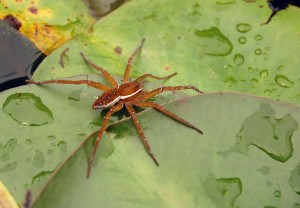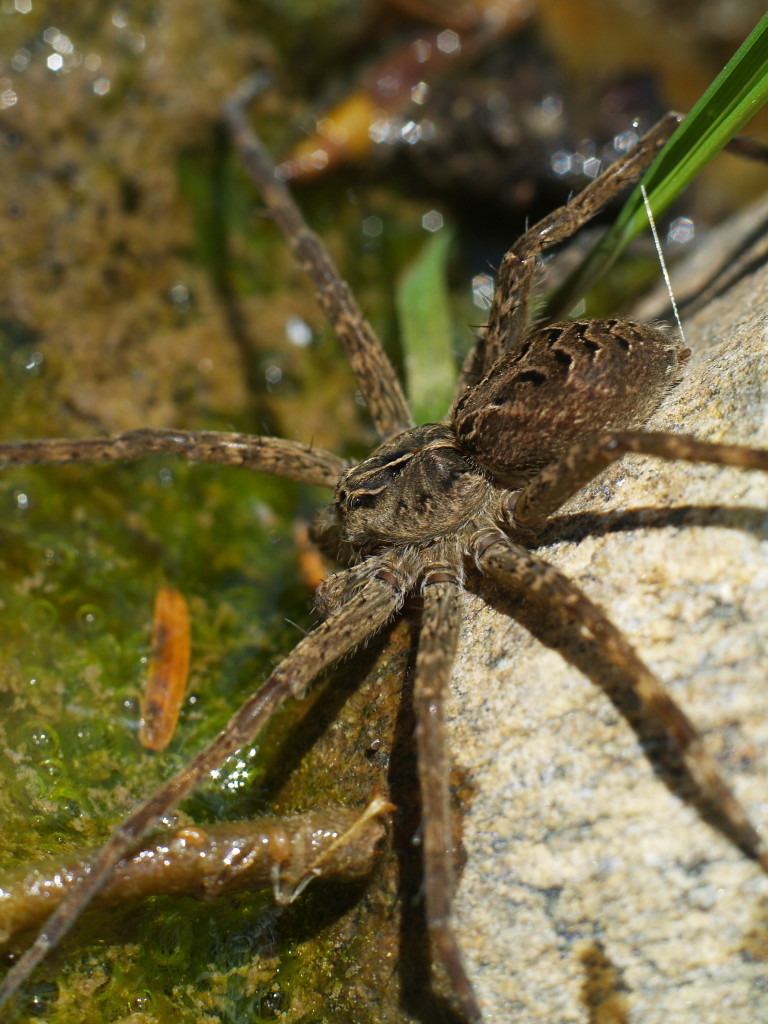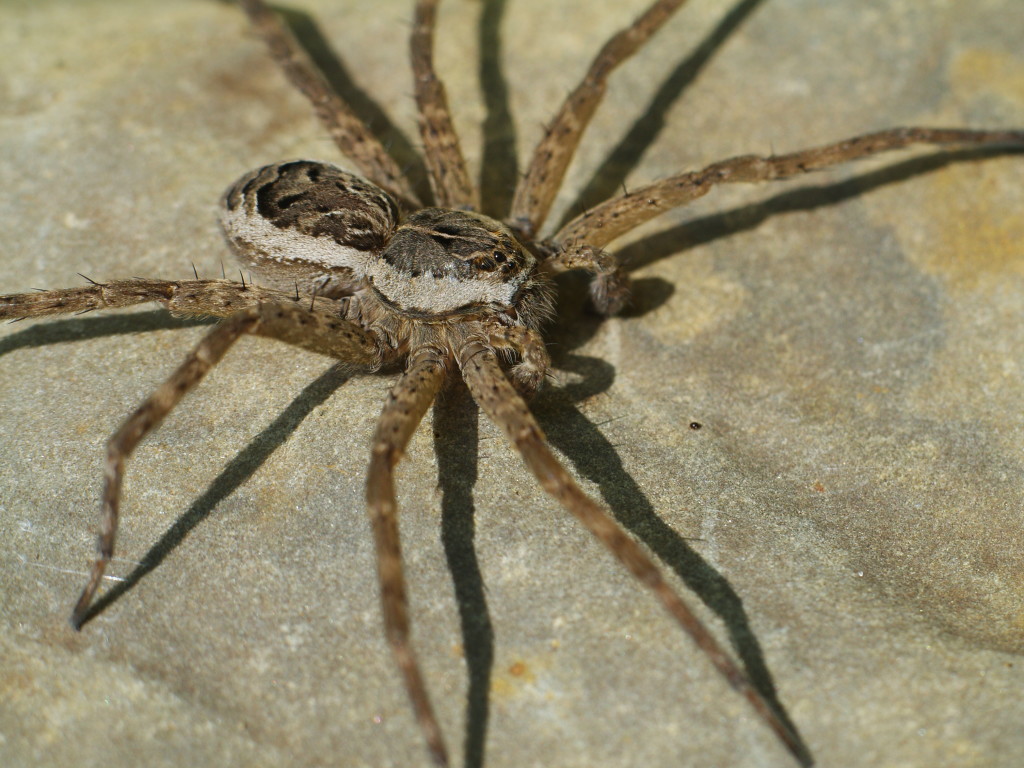by Jan Payne Wilson, SERC Volunteer

Six-spotted fishing spider, Dolomedes triton. Credit: Derek Ramsey
My dad was uncomfortable around spiders. Today we’d probably say he had a phobia. To deal with it, he found a spider-like creature, the Daddy Long Legs, and learned how benign and beneficial it was. From then on, he could focus on a “good spider” rather than his fear. As a child, I was indoctrinated with the knowledge that a Daddy Long Legs 1) could not bite you and 2) performed good deeds by eating “bad” spiders and other biting, child-frightening insects. Furthermore, they needed our help because they had delicate legs that easily broke off, so we moved them out of dangerous areas and avoided stepping on them. When I was older my father revealed that Daddy Long Legs weren’t actually spiders. Unlike true spiders, they can’t make silk and have neither fangs nor venom. From my father I learned that understanding a creature often changes fear into appreciation and, sometimes, amazement.
On the docks of the Smithsonian Environmental Research Center (SERC), I use my dad’s strategy to help students who either fear spiders or believe the only good spider is a dead spider. With Daddy Long Legs it’s easy. But we also have large spiders we don’t see as frequently: fishing spiders. When you see your first fishing spider, it’s a hard sell to believe she’s got redeeming characteristics.

Dark fishing spider Dolomedes tenebrosus, the largest fishing spider in Maryland. Credit: Er1kksen
What do they look like?
Females’ bodies can be an inch long. If you add her legs, she can be over 3 inches long, about the size of my index finger. In the spider world that’s big: One species, the “dark fishing spider” (D. tenebrosus), vies with wolf spiders for the title “Maryland’s largest spider.” (Male fishing spiders are generally half the size of females, so if you see a smaller fishing spider it’s not necessarily a juvenile; perhaps it’s a male.) They’re well camouflaged for both the water and the gray docks. Depending on the species, they can be a variety of grays, browns or greens with various patterns.
When and where should you look?
Most fishing spiders live two years, which means they hibernate. In the mid-Atlantic, the most common time to see mature, active fishing spiders is May through September. A hint on where to look comes from their name: If you’re going to fish, you’ll be near the water. Here at SERC you’ll most likely see fishing spiders on our docks. All are masters at standing patiently still, as you can imagine a spider that fishes must be. One morning, as I was giving my usual talk to a group of 4th-grade field trip students, I noticed a fishing spider on a pier next to me at the dock, a little below eye level. I talked and she simply stood; we shared the stage for 20 minutes and not one student saw her.
What do they do, and how?
Fishing spiders really do fish, although their prey is more often insects than fish. They need to be excellent predators since they eat up to five times their weight a day. The adaptations that allow this are good eyesight and fine hairs on their legs which feel ripples as insects land on or fall into the water. Fishing spiders seem able to locate downed insects based on the water’s movement. Much as web-spinning spiders use their webs to trap prey, fishing spiders use the water like a web.
In her common stance a fishing spider perches at the dock or waterside with her front two legs dangling in the water, and her body and other six legs firmly planted on land or dock. There, she waits to feel ripples that signal that a mayfly, waterstrider or other unlucky insect is briefly trapped or simply walking by. Then she springs into action using another adaptation that allows her to literally walk on water.
That’s right, fishing spiders walk on water. Covered by a waxy substance, her legs are waterproof, which helps keep her from sinking.
As for locomotion, fishing spiders have three gaits. In the usual method, when the tip of each leg touches the water, it creates a small indentation or dimple. Having spread her weight over these tips, she doesn’t break the surface tension of the water and thus doesn’t sink. By moving her legs in these dimples, something like skating, the spider walks on water.
Her second gait is faster. She moves her two middle pairs of legs like paddles, allowing her to move about 1 foot per second.
Using her third gait, she can run surprisingly fast. She moves her legs much as we do, lifting each waterproof leg but pushing it into the water, experiencing an opposing force that pushes her forward as she raises her other legs in succession.
Fishing spiders have one more amazing ability: They can dive deep enough to catch tadpoles or very small fish who’ve seen the “bait” of dangling legs. If a spider dives to avoid a predator she can stay submerged up to 30 minutes because a layer of breathable air forms between her body and the tips of her body hairs.

American fishing spider, Dolomedes scriptus. Credit: Er1kssen
Should we be afraid of fishing spiders?
The quick answer is no; they are harmless for most of us except for those who might be sensitive to spider venom. Furthermore, they are quite shy. If they are threatened (e.g., cornered), picked up or prodded, they can bite, but the result is similar to a bee sting.
And here is where I change my dad’s story: Spiders are beneficial, not bad. They eat a great variety of insects, and most knowledgeable gardeners welcome them into their gardens. While fishing spiders may not live in a garden, they do their share of insect eating. Like all spiders, they are part of the delicate balancing act in nature. When we can appreciate their amazing abilities and their role in the ecosystem, far from being frightened, we might find ourselves amazed.
Photos by Er1kksen used with permission under the Creative Commons Attribution 3.0 Unported license. Top photo by Derek Ramsey used with permission under the GNU Free Documentation License. Any re-use of that photo must also be published under the same license and include a link to the license.

